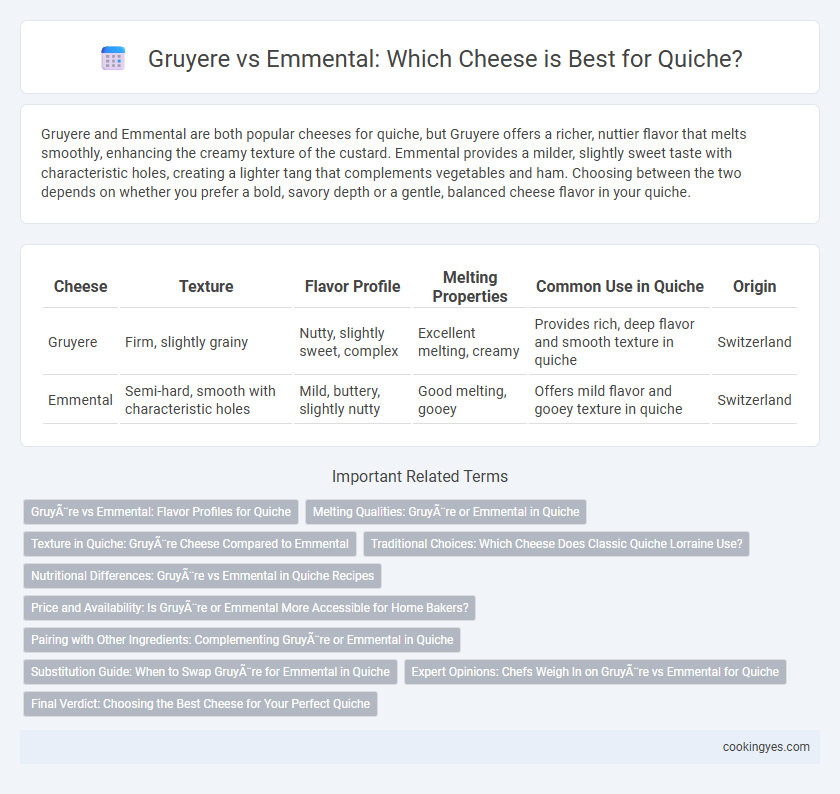Gruyere and Emmental are both popular cheeses for quiche, but Gruyere offers a richer, nuttier flavor that melts smoothly, enhancing the creamy texture of the custard. Emmental provides a milder, slightly sweet taste with characteristic holes, creating a lighter tang that complements vegetables and ham. Choosing between the two depends on whether you prefer a bold, savory depth or a gentle, balanced cheese flavor in your quiche.
Table of Comparison
| Cheese | Texture | Flavor Profile | Melting Properties | Common Use in Quiche | Origin |
|---|---|---|---|---|---|
| Gruyere | Firm, slightly grainy | Nutty, slightly sweet, complex | Excellent melting, creamy | Provides rich, deep flavor and smooth texture in quiche | Switzerland |
| Emmental | Semi-hard, smooth with characteristic holes | Mild, buttery, slightly nutty | Good melting, gooey | Offers mild flavor and gooey texture in quiche | Switzerland |
Gruyère vs Emmental: Flavor Profiles for Quiche
Gruyere offers a rich, nutty, and slightly sweet flavor that melts smoothly, making it ideal for quiche fillings seeking depth and creaminess. Emmental presents a milder, buttery taste with characteristic holes and a firmer texture, providing a subtle background that allows other ingredients to shine. Choosing Gruyere enhances the quiche with robust savory notes, while Emmental ensures a gentle, balanced cheese presence without overpowering the dish.
Melting Qualities: Gruyère or Emmental in Quiche
Gruyere offers a smooth, creamy melt with rich, nutty flavors that enhance the custard texture of quiche. Emmental melts more evenly with a mild, slightly sweet taste, providing a lighter cheese profile that blends well without overpowering other ingredients. Choosing between Gruyere and Emmental depends on the desired balance of strong flavor versus subtle creaminess in the quiche filling.
Texture in Quiche: Gruyère Cheese Compared to Emmental
Gruyere cheese offers a creamy, smooth texture that melts evenly in quiche, creating a rich and cohesive custard. Emmental has a slightly firmer texture with characteristic holes, which can lead to a more varied melt and a slightly less uniform consistency in the quiche filling. Choosing Gruyere enhances the quiche's silky mouthfeel, while Emmental provides a subtly elastic bite and distinct pockets of flavor.
Traditional Choices: Which Cheese Does Classic Quiche Lorraine Use?
Classic Quiche Lorraine traditionally uses Gruyere cheese, celebrated for its rich, nutty flavor and smooth melting properties that enhance the custard filling. Emmental, while also popular in French cuisine, offers a milder taste and more prominent holes, resulting in a different texture and less intense flavor contrast in the quiche. Choosing Gruyere over Emmental preserves the authentic taste and creamy consistency associated with traditional Quiche Lorraine recipes.
Nutritional Differences: Gruyère vs Emmental in Quiche Recipes
Gruyere cheese contains higher protein and calcium levels compared to Emmental, enhancing the nutritional profile of quiche with more muscle-supporting nutrients and stronger bone health benefits. Emmental offers slightly lower fat content and more vitamin B12, which supports energy metabolism and nerve function, making it a lighter yet nutrient-rich choice for quiche recipes. Choosing Gruyere or Emmental depends on whether the priority is richer calcium and protein intake or lower fat with increased vitamin B12 in the quiche's nutritional composition.
Price and Availability: Is Gruyère or Emmental More Accessible for Home Bakers?
Emmental cheese is generally more affordable and widely available in supermarkets compared to Gruyere, making it a popular choice for home bakers on a budget. Gruyere, known for its rich, nutty flavor, tends to be pricier and sometimes harder to find outside specialty cheese shops. Both cheeses melt well for quiche, but Emmental's accessibility and lower cost often make it the preferred option for everyday baking.
Pairing with Other Ingredients: Complementing Gruyère or Emmental in Quiche
Gruyere pairs exceptionally well with ingredients like caramelized onions, mushrooms, and smoky bacon, enhancing quiche with its rich, nutty flavor and creamy texture. Emmental complements lighter fillings such as spinach, ham, and fresh herbs, offering a mild, slightly sweet taste that melts smoothly. Choosing between Gruyere and Emmental depends on desired flavor intensity and ingredient profiles, with Gruyere suited for robust combinations and Emmental for delicate blends.
Substitution Guide: When to Swap Gruyère for Emmental in Quiche
Gruyere cheese offers a rich, nutty flavor and a creamy texture that enhances the depth of traditional quiche recipes, while Emmental provides a milder, slightly sweet taste with excellent melting properties. Substitute Emmental for Gruyere when you prefer a less intense cheese flavor or when aiming for a smoother, softer quiche filling without overpowering other ingredients. Use Emmental in quiches featuring delicate vegetables or herbs, reserving Gruyere for recipes requiring a robust, savory cheese profile.
Expert Opinions: Chefs Weigh In on Gruyère vs Emmental for Quiche
Chefs emphasize Gruyere's nutty, creamy profile enhances quiche by adding depth and a luxurious texture, while Emmental offers a milder, slightly sweet flavor that melts smoothly but lacks Gruyere's complexity. Expert opinions highlight Gruyere's superior browning and richness, making it the preferred choice for traditional quiche Lorraine recipes. Emmental is often recommended for a lighter, more subtle cheese experience in vegetable or less savory quiches.
Final Verdict: Choosing the Best Cheese for Your Perfect Quiche
Gruyere offers a rich, nutty flavor and melts smoothly, creating a creamy texture ideal for quiche. Emmental provides a milder taste with a slightly buttery profile, also melting well but resulting in a lighter, less intense flavor. For a perfect quiche, Gruyere is the best choice when seeking depth and complexity, while Emmental suits those preferring a subtler cheese experience.
Gruyère vs Emmental for quiche cheese Infographic

 cookingyes.com
cookingyes.com